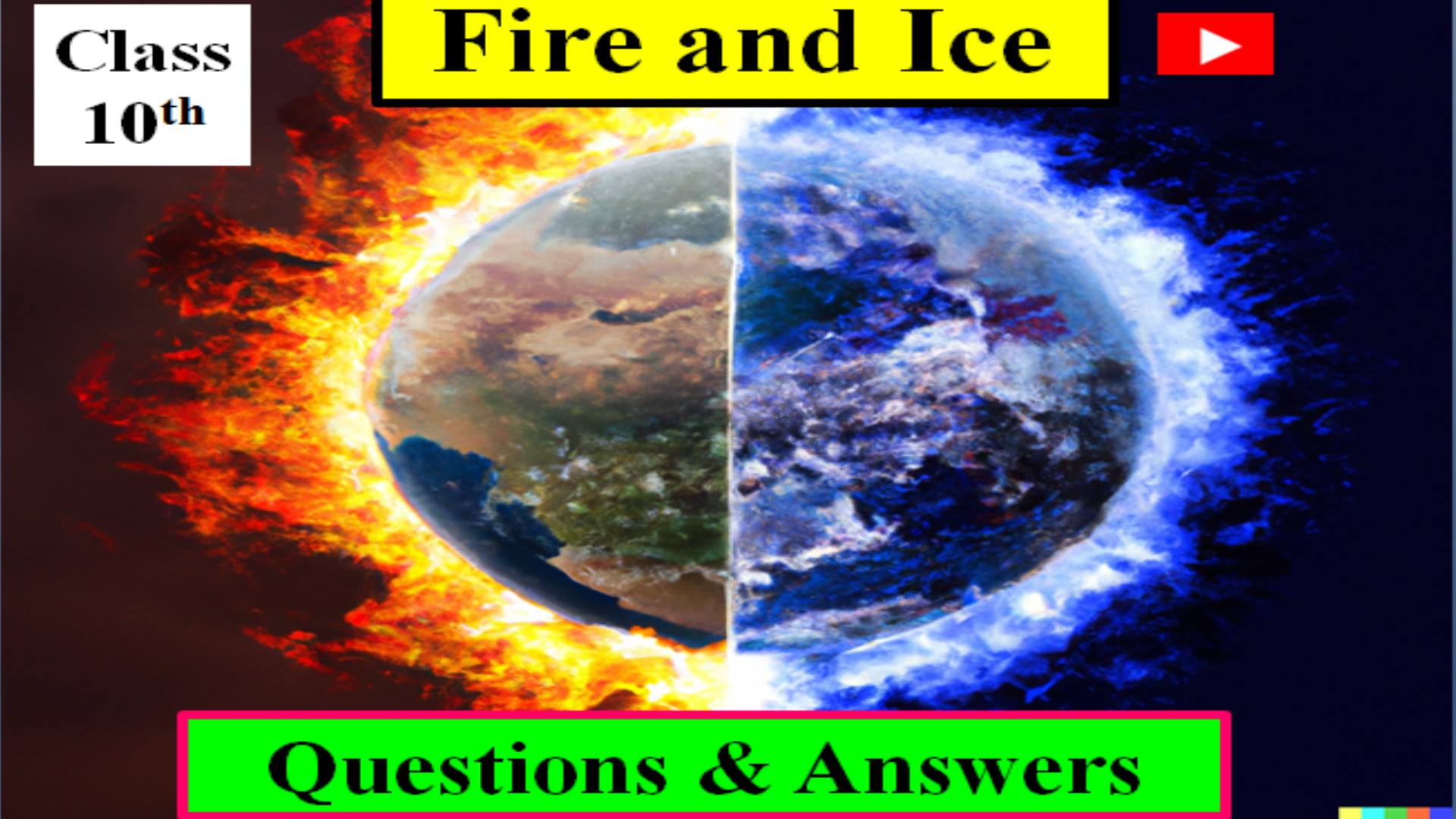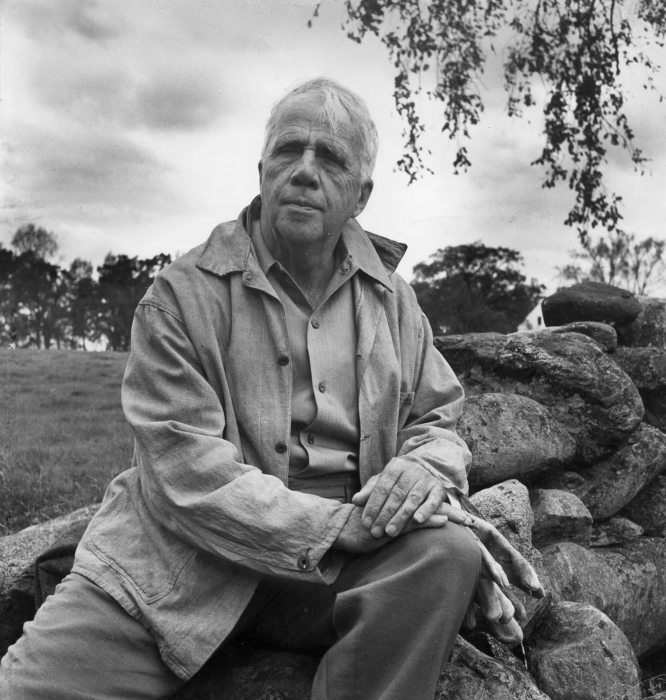
Fire and ice By Robert Frost
_Robert Frost
Summary
|
‘Fire and ice’ is a symbolic poem by Robert Frost where fire is used as an emotion of desire and ice is used for the emotion of hatred. Frost says that there are two possible ways how the world could end. One is by fire and the other is by ice. It may happen that the core of the earth will get so heated up that it would start a fire and wipe out civilisation or the temperatures would go so low that life will not be possible to live on the planet, thus, freeze everyone to death. The poet compares fire and ice with one’s desire and hatred respectively. The poet says that human beings let their emotions rule them and he would support the ones who are in favour of fire because of what he knows about “fiery desires” . Then, he says that if the world had to end twice, ice would be equally competent. He brings out a contrast between “ice” and “hatred”. Humans’ insensitivity and hatred has the capacity of inner destruction. Though slow and steady it has the same effect that desire has on us. If given to choose between fire and ice, ice would be as competent as fire to destroy the world. If fire would lead to rapid destruction, ice would be silent damage. The poem tells us that our emotions control us and if we don’t stop it, it will lead to utter chaos. |
Q. 1. There are many ideas about how the world will ‘end’. Do you think the world will end some day?
Have you ever thought what would happen if the Sun gets so hot that it ‘bursts’ or grows colder and colder?
Ans: There are definitely many ideas about how the world will ‘end’. I do believe that the world will end some day as anything that has a beginning will have an end. This stands true for the world also, if the Sun got so hot that it burst, the whole of the Earth would perish immediately as no part of the Earth can bear the heat of that intensity. But if the Sun grew colder and colder, everything will come to an end as without sunlight, life will end.
Q.2. For Frost, what do ‘fire’ and ‘ice’ stand for?
Ans: Here are some ideas,
‘Fire’ stands for greed, avarice, lust, conflict and fury. ‘Ice’ stands for cruelty, intolerance, rigidity, insensitivity, coldness, indifference and hatred
Short Answer Questions
1. What is ‘fire’ a symbol of?
Ans: ‘Fire is a symbol of lust and endless desires.
2. What is ‘Ice’ a symbol of?
Ans: ‘ice is a symbol of hatred.
3. What will fire do to the world?
Ans: Fire will put the world to an end.
4. What will the world end in?
Ans: The world will end in the fire as well as ice.
5. Why does the poet hold with those who favour fire?
Ans: The poet holds with those who favour fire because the lust for material things is increasing quickly.
6. Why do some people say that the world will end in ice?
Ans: They say so because hatred among people is increasing fast.
7. Who is the poet of the poem ‘Fire and Ice’?
Ans: Robert Frost.
1. What do you think would be enough to destroy the world? Can Fire and Ice contribute to it?
Ans: Our desires and hatred would be enough to destroy the world. According to the poet, `fire’ represents ‘desire’ and `ice’ represents `hatred’. Desires like fire spread rapidly and engulf one’s whole life. Similarly, ‘hatred’ fills life with poison.
2. What is the underlying idea of the poem ‘Fire and Ice’?
Ans: The poet equates fire with `desire’ and ice with ‘hatred’. Both of these are growing with enormous speed. If we don’t check them from growing, the world will perish. So we must restrain our desires and love our fellow-beings.
3. Which two ideas about how the world will end have been mentioned in the poem? Which idea does the poet support more?
Ans: The two ideas mentioned are that the world will end in fire or in ice. Though the poet thinks both are great for destruction, yet he seems to favour the idea of the destruction of the world in a fire a little more than in ice.
4. What does ‘fire’ and ice’ stand for and what is the general opinion regarding the world?
Or
According to the poet, what does ‘fire’ and ‘ice’ represent? Do you agree with him?
Ans: According to the poet, ‘fire’ represents desire and ‘ice’ represents hatred. I do agree with the poet. Desires like fire spread rapidly and engulf one’s whole life. Similarly ‘hatred’ fills the whole life with poison. It makes one hard-hearted and cruel.
5. What do people think about the ending of the world? What does the poet think?
Ans: Some people think that someday the world will end in fire. On the other hand some people say that it will end in ice. The poet has tasted both the fire and the ice. He thinks that the world will end in fire. Here fire stands for the tire of desire.
6. How will the world end twice?
Ans: The poet says that both fire and ice are destructive. Here fire stands for the heat of desire and ice stands for hatred He thinks that our violent desires will end the world. If it survives, it will be ruined by hatred.
7. What is the main idea of the poem?
Ans: The main idea of the poem is that there are violent passions in the world. They are destructive. But mare distinctive Mail those violent desires is the hatred between man and man. The poet thinks that one day this hatred will destroy the world.
8. Will this world come to an end? What does the poet say in this regard?
Ans: Everything that has a beginning or origin does have an end. It is an eternal law of nature. The existing world will come to an end, someday. The poet believed many people believe that either ‘fire’ or ‘ice’ will be the cause of the end of the world.
9. What do people think about the end of the world? Who does the poet side with and why?
Ans: People are divided over the cause of the end of this world. Some people think that ‘fire’ symbolised by unbridled passions, desires and fury will destroy this world. Others believe that ‘ice’ symbolised by cold reasoning, indifference and hatred will be the cause of destruction. The poet sides with those who believe that ‘fire’ or unbridled passions and desires will result in the destruction of the world.
10. Why does the poet say, ‘I’ve tasted of desire/I hold with those who favour fire?
Ans: The poet is familiar with the fire of passions and desires in love. He knows it quite well that are uncontrolled desires, passions and fury lead to our destruction. Similarly, he sides with those people who believe that ‘fire’ symbolised by unbridled passions and desires with be the real cause of the end of the world.
11. What will be the cause of the end of the world if it has to perish twice?
Ans: This world is not eternal. Its end is certain. The poet sides with those people who think that ‘fire’ will cause the end of the existing world. But if this world has to perish twice the ‘ice’ is as strong to bring the end of the world as ‘fire’ is. Icy reasoning devoid of human love and sympathy and hatred is sufficient to bring an end of this world.
12. How does the poet ‘know enough of hate’? Where will this ‘hate’ lead to?
Ans: ‘Icy’ or cold reasoning can lead to rigidity, indifference and insensitiveness. This can take away all warmth of human feelings, love and sympathy. The result can be disastrous. ‘Hatred’ born out of cold and ‘Icy’ reasoning can lead to the destruction of the world.
13. How will ‘ice’ be as ‘great’ and ‘suffice’ for causing the end of this existing world? Do you agree with the poet?
Ans: There is no need for ‘fire’ to destroy the world. Even ‘ice’ is sufficient and ‘strong’ enough to cause the destruction of this world. If this world has to ‘perish twice’, then there is no need for fire to destroy it twice. ‘Ice’ is as ‘strong’ and ‘great’ a cause that can cause the end of this world.
14. What is the message of the poem ‘Fire and Ice’?
Ans: The metaphors of ‘fire’ and ‘ice’ are used very effectively to convey a definite message to the readers. ‘Fire’ here stands for our unbridled, uncontrolled and unchecked passions, desires, lust and fury. Such passions are disastrous for human beings. Similarly cold reasoning devoid of all human warmth, love, sympathy will bring insensitivity, cruelty and rigidity. This hatred will lead to the end of this world.
15. From when I have tasted of desire
I hold with those who favour fire.
Why does the poet hold with those who favour fire?
Ans: The poet sides with those who believe that the world will be destroyed by fire. ‘Fire’ is a symbol of desire. The poet has already experienced desire. On the basis of his experience, he knows that excessive desire will destroy the world. That is why he holds with those who favour fire.
16. But if it has to perish twice
I think I know enough of hate.
What does ‘it’ refer to? How will it perish twice?
Ans: ‘It’ here refers to the world. The poet says that people hold different opinions about the end of the world. Some say ‘fire’, which stands for ‘desire’, will destroy the world. Secondly, ‘ice’, which stands for ‘hatred’ can also destroy the world.
17. To say that for destruction ice
Is also great
In the poem what does ‘ice’ stand for? How is it sufficient to bring destruction?
Ans: ‘Ice’ stands for ‘hatred’. Hatred may be religious, communal or of any other type. According to the poet, there is enough hatred in the world which will destroy the external, physical world one day.
Long Answer Type Questions
1. How does the poem depicts the two contrasting ideas— ‘Fire’ and ‘Ice’? Can hatred destroy us and the world? Explain bringing out values which can make this world a better place to live in.
Ans:
(i) In this poem, Robert Frost refers to two contrasting ideas—Fire and Ice as predictions of how the world will end. According to him, some people say that the world will end in a fire while some others hold that this will end in ice. The poet equates desire with fire and hatred with ice. Both the desire and hatred are growing with such a rapid speed that the world will come to an end either of the ways.
(ii) Yes, hatred can destroy us and the world. Intolerance in behaviour creates hatred that leads to fury and cruelty. One becomes hard-hearted and insensitive to the feelings of others.
(iii) Love, brotherhood, tolerance, peace, contentment, sensitivity, benevolence, and generosity among people can make this world a better place to live in.
2. What is the rhyme scheme of the poem? How does it help in bringing out the contrasting ideas in the poem?
Ans: The rhyme scheme of the poem in the first stanza is a, b; a band in the second stanza it is – a, b, a, b, a.
The lines ending with the same rhythm have the same idea but the line that ends with a different note has the contrasting idea. In the first stanza, the first, third and fourth lines end with the words fire, desire, fire – same rhythm but the second line ends with the word ‘ice’, a different note, also it contrasts with ‘fire’.
Thus the poet has brought out the contrasting ideas in the poem by using different rhythms.
3. There are many ideas about how this world will come to an ‘end’. What are they? Do you agree with the poet and his understanding of the poet and his understanding of the issue in this regard?
Ans: Almost all think that this world will end at one time or the other. It is true that everything that has a beginning or origin will come to an end too. There are many ideas about how this world will come to an end. Some think that ‘fire’ will be the cause of the ‘end’ of the world. Others believe that ‘ice’ will bring the end of the world. Both of these ideas have their valid reasons. The poet sides and stands with those who believe that ‘fire’ will be the cause of the ‘end’.
The poet is well aware of how the ‘fire’ of unbridled passions, desires, lust, and fury can lead to the destruction of humanity and the world. But the other view is equally convincing. Cold and ‘icy’ reasoning can create insensitivity, rigidity, frigidity, and indifference in man. Ultimately, it breeds ‘hatred’ and contempt. This kind of ‘icy’ reasoning which is devoid of all human warmth, sympathy, love, and understanding will only bring destruction and death of this world.
I believe that both ‘fire’ and ‘ice’ have strong potentialities to bring disasters and destruction to the world.
4. What do the metaphors of ‘ice’ and ‘fire’ convey to the readers? Don’t they represent the two extremes of human behaviour that can lead to the destruction and death of this world? What is the message that the poet wants to give to the readers?
Ans: The poet has touched the universal issue of the ending of this existing world. He gives a message as well as a warning to human beings. Man is swaying between two extremes — ‘fire’ and ‘ice’. Sometimes he is torn by his unbridled fire of passions, desires, lusts, longings, and fury. This results in greed, avarice and passionate love. All such extremes can lead to unavoidable conflicts and disasters. If not controlled, they can help in bringing an early end of this world.
The other extreme behaviour of human beings is born out of cold and ‘icy’ reasoning. When our cold reasoning becomes completely devoid of human warmth, feelings, love, and sympathy, it breeds hatred. Hatred born out of cold indifference, insensitivity and rigidity are strong enough to cause the end of this world. Humanity can redeem itself and possibly save or delay the end of the world by giving up such extremes of thinking and behaviour.

